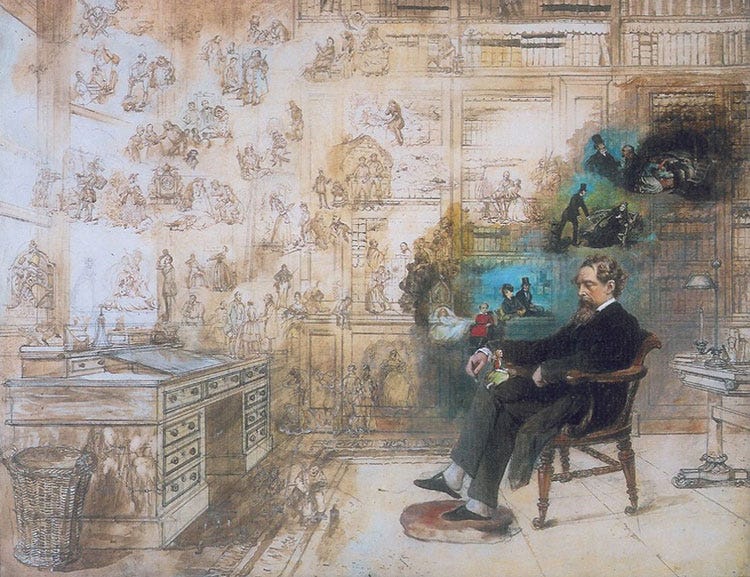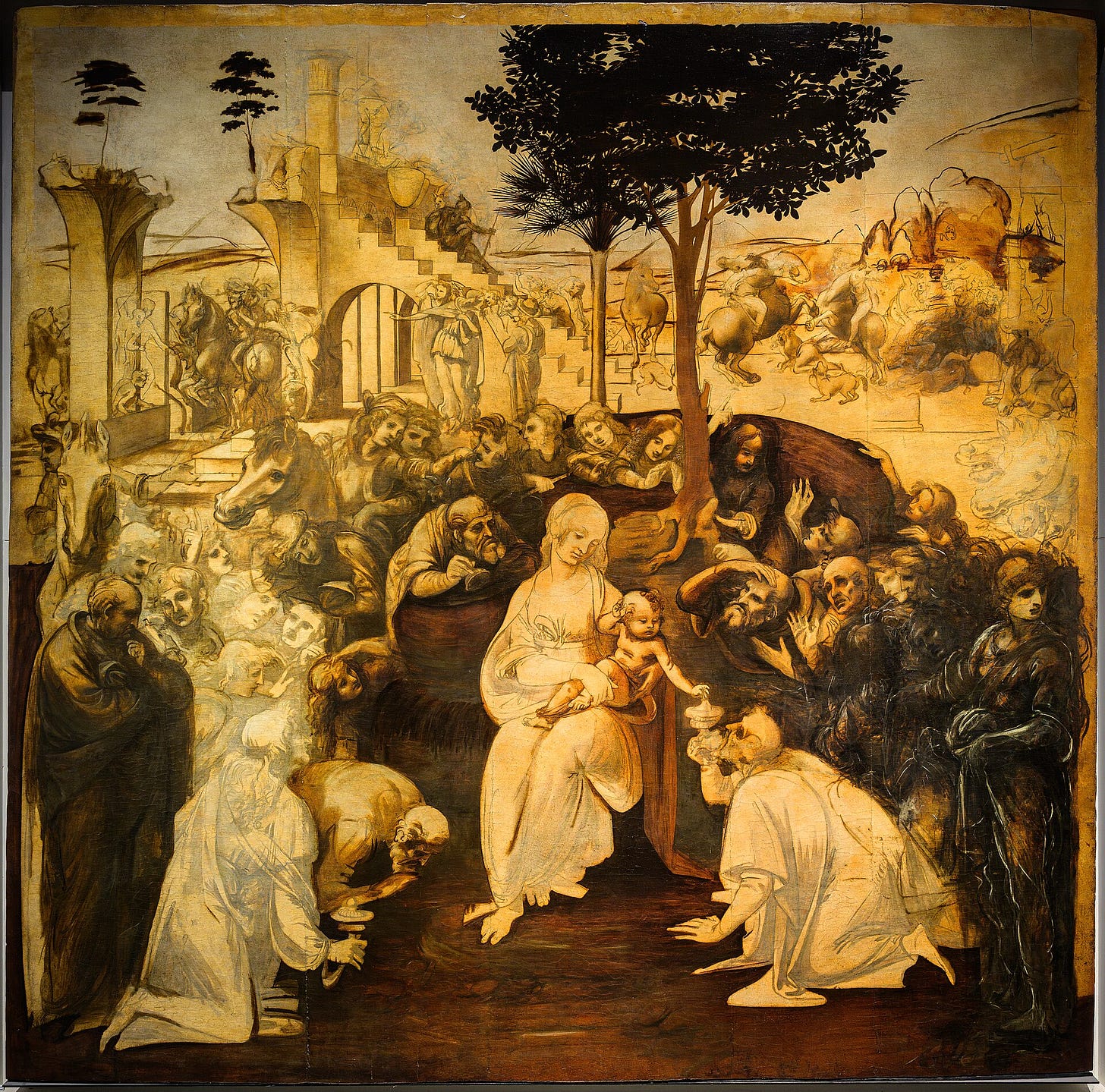15 Works that Prove Great Art is Often Unfinished
You're not a perfectionist. You're just afraid.
Welcome back to Can’t Get Much Higher, a newsletter dedicated to music in all shapes and sizes, often with an analytical bent. Some of recent stories have been about Kidz Bop, sad comments on YouTube videos, and using data to uncover the latest standards. Today, I don’t want to talk about any of that. I want to talk about Def Leppard and unfinished masterpieces.
If you enjoy this newsletter or this piece, consider ordering a copy of my book Uncharted Territory: What Numbers Tell Us about the Biggest Hit Songs and Ourselves. It’s a data-driven history of popular music covering the period from 1958 to 2025.
15 Works that Prove Great Art is Often Unfinished
By Chris Dalla Riva
Def Leppard spent so much time and money recording their 1987 album Hysteria, that they allegedly had to sell five million copies just to break even. Though sales were sluggish at first, the album ended up being a huge success, spawning six top 40 singles, including “Love Bites” and “Pour Some Sugar On Me.”
The making of this album is stuff of legend. Rather than recording the songs as a band, producer Mutt Lange insisted on recording many things note-by-note for maximal control. Entire songs were recorded and then scrapped. Others, like “Animal,” allegedly took three years to bring to life. Amid this desire for musical perfection, the band also faced countless personal setbacks. Drummer Rick Allen lost his arm in a car crash. Singer Joe Elliot also came down with a case of mumps.
Of course, everything worked out in the end. The album sold millions of copies on its way to becoming a classic. And in many ways, it stands as a great example of musicians having an uncompromising vision and working until they realize it. But as I’ve learned more about music (and made some myself), I’ve come to think that the making of Hysteria is often at odds with how much great art is made. In fact, I think great art is often unfinished.
#1 “Wichita Lineman” by Glen Campbell
Over the last few months, I started a new series here called The Take. The premise is simple. I send a notable artist or songwriter three random songs and they send me back their reactions. In a recent edition, I sent Bowling For Soup frontman Jaret Reddick “Wichita Lineman” by Glen Campbell. Reddick aptly described the song as “a classic.”
In the course of sending Reddick the song, I came to learn that “Wichita Lineman” has a strange history. The song was conceived by Jimmy Webb, the tunesmith behind classics like “Up, Up and Away” and “Worst That Could Happen.” When he sent Campbell and his team a demo, he only had two verses written. He planned on adding a third verse and bridge. Campbell and his team were antsy, though. They cut the song as is.
“A couple of weeks later I ran into him [Glen Campbell] somewhere, and I said, ‘I guess you guys didn't like the song,’” Webb recalled decades later to the BBC. “[Campell] said, ‘Oh, we cut that.’ I said, ‘It wasn't done! I was just humming the last bit!’” Thus, a half-baked idea that was tossed off pretty quickly has become hailed as a classic with such depth that it inspired an entire book in 2019: Wichita Lineman: Searching in the Sun for the World's Greatest Unfinished Song.
#2 “Mr. Brightside” by The Killers
Released as their debut single in 2003, The Killers’ “Mr. Brightside” is arguably the most famous rock song of the 21st century so far. Here’s how it starts:
Coming out of my cage and I've been doing just fine
Gotta, gotta be down, because I want it all
It started out with a kiss, how did it end up like this?
It was only a kiss, it was only a kiss
That’s a very strong beginning. You’re thrown right into the action. When you get to verse two, you might assume that the lyrical narrative will continue to develop as happens in most songs. That’s not the case with “Mr. Brightside.” Frontman Brandon Flowers just sings the same verse again. “The second is the same as the first,” he told Spin in 2015. “I just didn’t have any other lines and it ended up sticking.”
#3 “The Sound of Silence” by Simon & Garfunkel
After releasing their debut studio album Wednesday Morning, 3 A.M., Simon & Garfunkel effectively broke up because the record was a commercial failure. That album contained the duo’s now-classic “The Sound of Silence.” Like the record it belonged to, it had little to no impact upon release.
About six months later, producer Tom Wilson — who had recently worked on Bob Dylan’s first electric sessions — noticed that some DJs started spinning “The Sound of Silence.” Without the duo’s permission, he added a backing band to the original acoustic recording. When Paul Simon was reading Billboard in the fall of 1965, he noticed that “The Sound of Silence” was charting. He grabbed a copy of it and was shocked when he heard the band behind his acoustic number. The recording would later top the Hot 100. Without the vision of meddling producer, Simon & Garfunkel might not have had a career.
#4 Freaks and Geeks produced by Judd Apatow
On Rolling Stone’s 2022 list of the greatest television shows of all time, they list Freaks and Geeks at number 24. That’s astounding. Though the show helped launch the careers of Seth Rogan and Jason Segal, there isn’t even a complete season. The show was marred by scheduling issues and network executive infighting. Would the show still be considered great had it run for multiple seasons? It’s hard to say. There are many television shows that can’t sustain after a great season. But with Freaks and Geeks, we only have those initial episodes to go on.
#5 Smile by The Beach Boys
The audio equivalent of Freaks and Geeks might be Smile, The Beach Boys’ unfinished follow up to Pet Sounds. Whereas the demise of Freaks and Geeks was outside of control of executive producer Judd Apatow, Smile’s lack of completeness is largely tied to its creator, Brian Wilson. Battling mental health issues, Wilson — a known perfectionist — blocked most of its release for decades.
Though we don’t know if Freaks and Geeks would have sustained its quality had it continued, we know that Smile would have lived up to the hype. In 2011, all of the recordings and outtakes were packaged up as The Smile Sessions. It received near-universal praise and won a Grammy.
#6 “I’m Shipping Up to Boston” by Dropkick Murphys
In the early 2000s, Dropkick Murphys’ frontman Ken Casey was invited to check out the archives of folk music legend Woody Guthrie. During that fateful day, Casey came across an unfinished lyrical fragment:
I'm sailor peg
And I've lost my leg
A climbing up the topsails
I've lost my legI'm shipping up to Boston
Shipping off to Boston
Shipping out to Boston
To find my wooden leg
There isn’t much information about when Guthrie penned these humorous lyrics or what inspired them. To my ear, it sounds like he might have been inspired by Herman Melville’s Moby-Dick. That’s just speculation, though. Regardless, Casey and his bandmates set those long lost lyrics to music. This cross-genre, intergenerational collaboration became “I’m Shipping Up to Boston,” a Celtic punk classic.
Similar to “Mr. Brightside,” this classic is just the same verse and chorus repeated twice. The repeat in “Mr. Brightside” is very different than the repeat here, though. The Killers repeat was partially out of necessity. They were pressed for time when recording their first songs. The Dropkick Murphys, on the other hand, were stuck with an unfinished stanza from decades ago. A Boston.com piece on the song notes, “Casey agrees that some sort of cosmic force must have compelled him to find the now iconic lyrics buried within the thousands and thousands of pages Guthrie left behind.”
#7 La Sagrada Família by Antoni Gaudí and Francisco de Paula del Villar
In 1882, construction began on a new church in Barcelona: La Basílica i Temple Expiatori de la Sagrada Família, often shortened to La Sagrada Família. In 2005, it was declared a UNESCO World Heritage Site. In 2010, Pope Benedict XVI declared it a “minor basilica.” In 2024, it had a record 4.83 million visitors. The funny thing? It’s technically not complete. The church has been under construction for 143 years.
The church will allegedly be finished in 2026, but I don’t think it really matters. Sometimes a work is so imposing that it doesn’t have to be complete for you to understand its greatness. Plus, is it ever possible to be finished praising God?
#8 Dickens’ Dream by Robert William Buss
Below is Dickens’ Dream, an arresting work of art painted by Robert William Buss in celebration of the work of Charles Dickens. Like Dickens’ final novel The Mystery of Edwin Drood, the work was never completed. Here’s how David A. Perdue described the painting on his website dedicated to Dickens:
Robert William Buss was hired by Dickens' publishers, Chapman and Hall, to provide two illustrations for [The Pickwick Papers] after the original illustrator, Robert Seymour, committed suicide. The publishers were disappointed with the illustrations provided by Buss and the job went to Hablot Browne. Buss, however, remained a lifelong admirer of Dickens and produced several paintings celebrating the author's work. The watercolor, Dickens’ Dream, showing the author surrounded by the characters he created, was done after Dickens death in 1870. Buss himself did not live to complete the painting. The painting is now in the Charles Dickens Museum, London.
Though La Sagrada Família is incomplete, we know it’s a masterpiece because much of it is done. Dickens’ Dream is different. There is clearly a lot that still has to be completed here. But part of what is so memorable about the painting is its incompleteness, the little bit of color suggesting the great British author dreaming up plots. Had Buss finished it, it might not have been as compelling.
#9 Around the World in a Day by Prince
In 2018, when The Current, a Minneapolis radio station, asked Prince’s long-time sound engineer Susan Rogers about how fast the musical legend worked in the studio, here’s what she said:
Admittedly the sound of Around The World In A Day is not as high fidelity as the sound of the Purple Rain album, because the majority of the Purple Rain album was done at Sunset Sound, which is some of the finest audio technology in the world. In contrast, most of Around The World In A Day was done at the warehouse using lower quality, to say the least, because we were working at a rehearsal space. We didn’t even have acoustical isolation. His ideas were bubbling up so fast — you can imagine a volcano just overflowing, and we were setting pots and pans underneath the lava flow just trying to catch it. That’s how quickly he was working. So high fidelity, no. That record would not win any prizes for the best engineered recordings, but what he taught me is that when people buy a record, they’re not buying the sonic quality. That’s not what they go into a record store for. You go into a record store for music. You turn that radio dial for music, not for sound. If the musical ideas are good, that takes precedence over the sonic quality.
Frankly, I think this description captures many of Prince’s classics. Though the musical ideas are fully realized, the recordings sometimes feel like demos, like Prince thought they were done when most other people thought they were just getting started.
#10 “(Sittin' On) The Dock of the Bay” by Otis Redding
Otis Redding never got to see the heights of his own success. When his “(Sittin' On) The Dock of the Bay” reached the top of the Billboard Hot 100, the soul legend had been dead for four months. Apparently, before he died, Redding intended to do more work on the song, some sources claiming that he wanted to replace the whistling at the end. With Redding in the ground, it was up to his collaborator Steve Cropper to finish the song. Had Redding survived, we’ll never know if he would have insisted on changing his masterpiece.
#11 The Canterbury Tales by Geoffrey Chaucer
Often regarded as one of the greatest and most influential texts in the English language, Chaucer’s magnum opus is incomplete. The Canterbury Tales contain 24 stories, mostly written in verse. That said, the general consensus is that Chaucer intended to write 120. He died before he could complete them. That hasn’t stopped the reverence of the text.
#12 The Adoration of the Magi by Leonardo da Vinci
Though incomplete in the same way that Dickens’ Dream is incomplete, da Vinci’s Adoration of the Magi is considered one of his important early works. While part of the celebration around this work is just that it was painted by da Vinci — a man with endless talents but not that many extant paintings — I also find this work arresting in its current state.
#13 “Louie Louie” by The Kingsmen
“Louie Louie” is chaos, an explosion of sound for almost three-minutes, most lyrics completely unintelligible. The song and recording are technically complete. It was composed by journeyman doo-wopper Richard Berry. And despite the chaos, The Kingsmen’s recording clearly involved some planning given that they swing the rhythm of the main riff a bit differently than the original. Plus, it is a complete take of the song.
Still, it wasn’t recorded in the same way Def Leppard’s Hysteria was recorded. While Def Leppard spent years on single songs, The Kingsmen got two takes. And those takes were filled with mistakes. For example, you can hear the lead vocalist come in too early after the guitar solo. Rather than fixing that error, they just kept it in. Those mistakes have become rock canon, inspiring legions of kids to pick up guitars and paving the way for garage rock and punk. Often, we think of “completeness” as meaning error-free, but sometimes errors give an artistic work its life.
#14 The Trial by Franz Kafka
Racked with self-doubt, Franz Kafta neither completed nor published almost anything he wrote during his brief four decades on Earth. In fact, he is said to have burned nearly everything he wrote and ordered his friend Max Brod to destroy everything else after his death. Thankfully, Brod defied his friend and had what remained published, including The Trial. Though unfinished, The Trial is considered a masterpiece. In 1999, the French newspaper Le Monde named it the third greatest novel of the 20th century.
#15 “I’m Not There” by Bob Dylan
Bob Dylan may be the king of unfinished art. And I don’t mean because he is known to have scores of outtakes. I mean because his compositions are in constant flux, being rearranged and reimagined by the day. In Old Weird America, Greil Marcus’s famed book about Dylan’s Basement Tapes, he relates a story about one of Dylan’s most famous unfinished composition, “I’m Not There”:
Going through the host’s record collection, she found a bootleg album that included “I’m Not There,” a legendary never-released, never-completed song from the Basement Tape sessions — a song that she’d heard just once, and that she’d been searching for ever since. It came on as she was talking; it was even more haunting than she remembered …
“This,” she said, “may be the greatest song ever written.”
Is it possible for an unfinished song to be “the greatest song ever written”? Yes. That’s kind of the entire point of this piece. Sometimes unfinished works are great because they’re close enough to completion that we get the point, like La Sagrada Família. Sometimes unfinished works are great because the artist didn’t realize they were done, like “Wichita Lineman.” Sometimes unfinished works are great because they suggest the greatness that might have come had they been completed, like Freaks and Geeks. And sometimes unfinished works are great because they are being created endlessly, like “I’m Not There.”
If you’ve been sitting on some piece of art for years that you just can’t finish, I implore you to put it out as is. People often blame their lack of output on perfectionism when in reality the issue is fear. Genuine perfectionists toiling away on small changes that actually improve things are few and far between. Take the chance. Shout into the void. Release your art. You might have a masterpiece on your hands.
Shout out to the paid subscribers who allow this newsletter to exist. Along with getting access to our entire archive, subscribers unlock biweekly interviews with people driving the music industry, monthly round-ups of the most important stories in music, and priority when submitting questions for our mailbag. Consider becoming a paid subscriber today!
Recent Paid Subscriber Interviews: Pitchfork’s Editor-in-Chief • Katy Perry Collaborator • Spotify’s Former Data Guru • Music Supervisor • John Legend Collaborator • Rock Critic • What It’s Like to Go Viral • Adele Collaborator
Recent Newsletters: Pop Music Kill Rate • The Lostwave Story • Blockbuster Nostalgia • Weird Band Names • Two-Hit Wonders • A Frank Sinatra Mystery
Want to hear the music that I make? Check out my latest single “Give It To Me” wherever you stream music.






Well chosen examples of a trend that I didn't even realize existed. Nicely done!
Lovely piece of work, really enjoyed that. Did get me wondering - what exactly defines "finished"? In a lot of cases it's a bit ambiguous, just comes down to the artist stopping working on it. But it's not a clearly defined line, in many cases